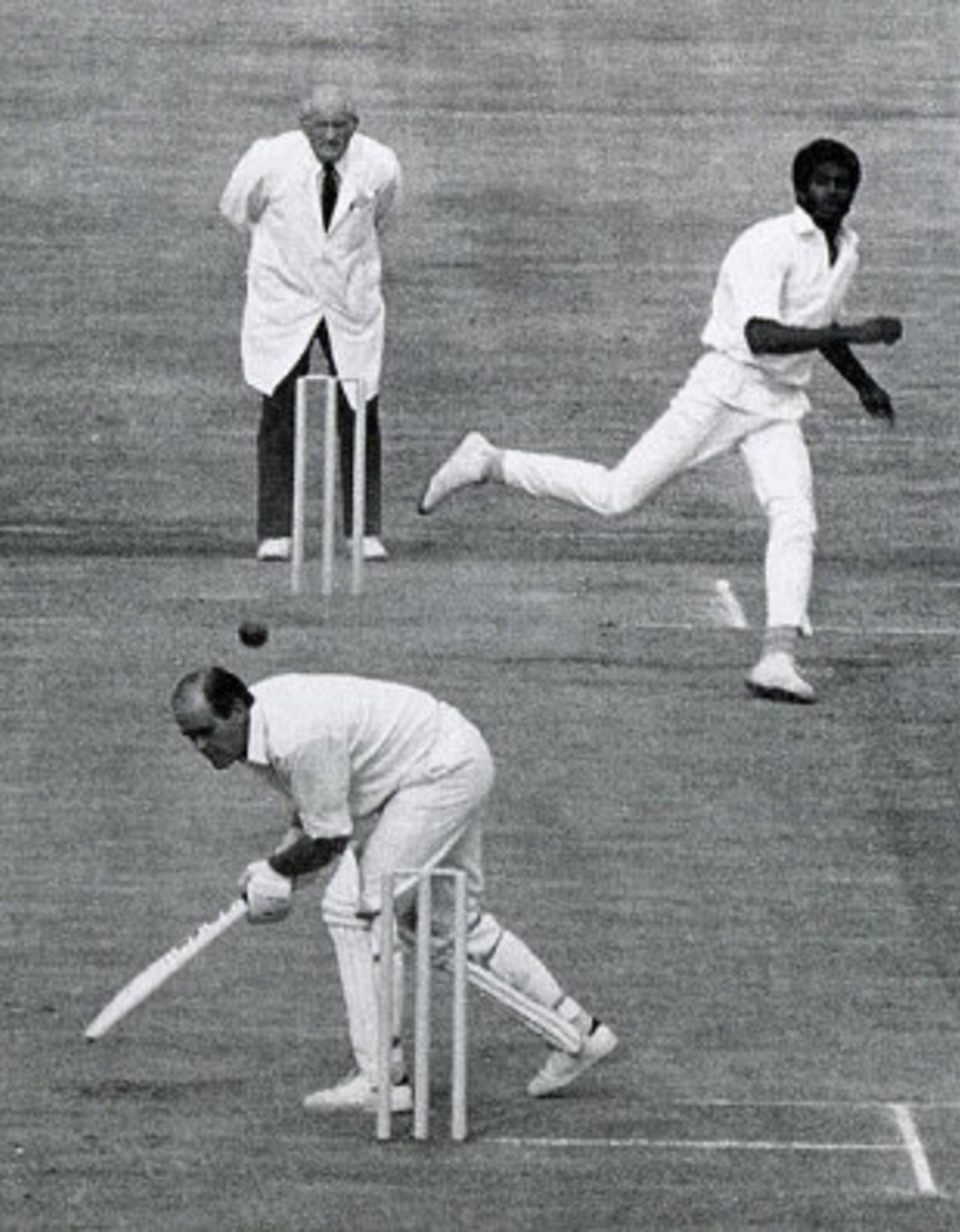Life of Brian
Sixty years ago he was a prodigy who served notice to the world - before he went missing and later turned up as a brave old man against the West Indies firing squad
Alan Hill
04-Aug-2009

Courage under fire: Close weathers the West Indian barrage in his mid-40s • The Cricketer International
All those who watched the ferocious gladiator in his magnificent opening season testify to his thrilling command as a batsman. Brian Close's power and supremacy at the crease provided onlookers with an early demonstration of the adventurous approach that always governed his cricket.
Raymond Illingworth, a close friend and later an astute ally in Yorkshire's championship years in the 1960s, remembers the confidence of the imperious young giant. "At 18, Brian was the finest straight driver I'd ever seen. He used to pepper the rugby stand at Headingley - and that's a big hit."
One example of Close's striking powers came in the match against Derbyshire at Park Avenue, Bradford. Close was in opposition to the fast bowling trio of Gladwin, Jackson and Copson, all of them England players. Illingworth recalls the entry of Close and the subsequent barrage of strokes, which produced near-delirium in the spectators. Copson conceded 45 runs in five overs. As Illingworth recalls, one of Close's two sixes rose mightily to land on the roof of the stand. The Yorkshire Post correspondent enthused: "Close gave the Derbyshire attack a Jessop-like hammering, using his long arms to hit out with terrific swings."
Trevor Bailey has watched, played and written about cricket for over 80 years. He was present when Peter Smith, his Essex colleague, was subjected to another tremendous barrage of shots. Close was unbeaten on 88, with a hundred at his beckoning, when Yorkshire declared. "It was a magnificent performance," says Bailey. "We were all astonished by his big hitting at Headingley." Bailey still believes that Close was the best young player of his time and was unrivalled until Sachin Tendulkar displayed his own uncommon artistry.
The gods smiled on Close in the momentous summer of 1949. He became the youngest player, aged 18 years and 149 days, to represent England in a Test match. He made his debut against New Zealand at Old Trafford. Other distinctions followed. He was the youngest Yorkshireman to gain his county cap, which followed national recognition, and the youngest allrounder to achieve the double, and he was the only player ever to reach this milestone in his first season.
Sporting prodigies carry the burden of high expectations. Close in his cricketing infancy was praised as a wondrous talent. There were some among the Yorkshire elders who urged more sober consideration. Jim Kilburn, the historian and cricket correspondent, offered a typically measured response. "Close has the grace and balance of a natural player of games. Nobody would wish to withhold congratulations and hopes for a famous future." Kilburn's next words might have been a premonition; they certainly reflected the anxiety felt by other admiring bystanders. "Hero worship and success make for a heavy wine and it would be a cricketing tragedy if unbalanced enthusiasm were to lead a young player into a mood of complacence."
The buoyancy of the rough-hewn Yorkshire boy was crushed on an ill-starred tour of Australia in 1950-51. The failure to nurture an immature youth would deprive England of an allrounder who could have vied with the greatest in the game. Close became a lonely and disconsolate boy on the tour and was derided as a misfit by his captain, Freddie Brown. Brown was an amateur martinet of the old school. He had, in fact, overridden the objections of the Yorkshire committee to include Close in the touring party. That was the worst thing that could have happened to Brian," says another Yorkshire veteran, Ted Lester. "The promotion was too sudden; he would otherwise have been in the England team for the next 20 years."
"The promotion was too sudden; he would otherwise have been in the England team for the next 20 years"Ted Lester, Yorkshire veteran
The late Ronnie Burnet tells a revealing story of the impact of the demoralising experience in Australia, which had, he recalled, almost resulted in Close's giving up the game. In one long conversation Burnet had tried to dispel the clouds of depression. "You're wasting your breath," said Brian, "I'm finished."
Close did linger on the brink of despair for some time afterwards, but he eventually emerged from his dejection to embark on an exhilarating new phase as Yorkshire captain in the early 1960s. He was then 32 and found assurance and peace of mind in a coveted leading role. Bill Bowes, another Yorkshire elder, was among those astonished at the impact of Close as captain. "Brian's field placings were as intelligent and antagonistic as any seen in the county for 25 years," says Bowes.
Yorkshire won four championships and two Gillette Cups in an invincible decade. Close was now the hard man of cricket folklore. His courage as a batsman was notably displayed against the ravenous West Indies pacemen in 1963, and even more remarkably at the age of 45 when he was recalled by England for the last time against other marauders from the Caribbean in 1976.
His swansong as a cricketer produced new tributes when he moved to captain Somerset. At Taunton he nurtured the talents of a player who was cast in a similar coinage to his youthful self. Close rescued Ian Botham from the clutches of disapproving coaches on the Lord's groundstaff to help propel him to legendary status.
Sir Ian today says: "Closey was a great leader and a remarkable man. We will always be indebted to him. He was the man who put us on the road and transformed a happy-go-lucky band, as Somerset was regarded, into the winning machine we became."
Alan Hill is the author of Brian Close - Cricket's Lionheart